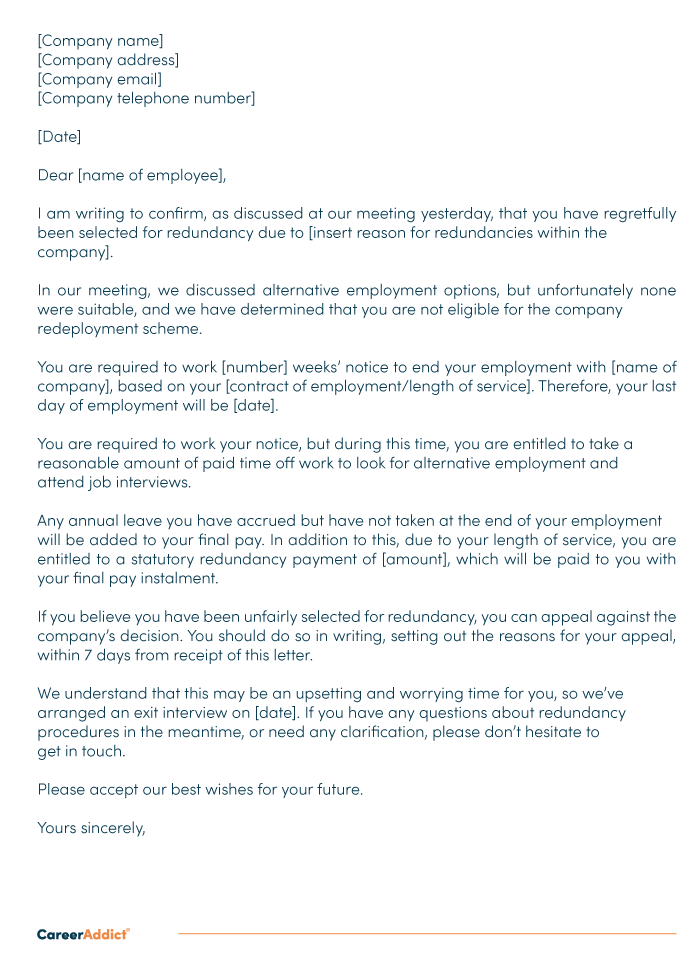Redundancy Pay If Company Goes Bust: Comprehending Your Entitlements in the UK
Redundancy Pay If Company Goes Bust: Comprehending Your Entitlements in the UK
Blog Article
Exploring the Operational Characteristics of Business Redundancy and Its Long-Term Sustainability

Redundancy Methods for Business Connection
In order to make certain nonstop operations, services should carry out efficient redundancy methods for service connection. Redundancy in this context refers to the duplication of critical components or features within a system to alleviate the impact of potential failures. By integrating redundancy approaches, organizations can improve their strength versus disruptions caused by different aspects such as all-natural calamities, equipment failures, or cyber-attacks.
One common redundancy method is the execution of back-up systems and data storage services. This includes developing duplicates of vital information and systems that can be turned on in instance of a main system failure. Additionally, organizations can establish redundant communication channels and power sources to maintain connectivity and procedures throughout unforeseen events.
Additionally, cross-training staff members to execute multiple functions within the firm can work as a valuable redundancy approach. If key workers are unavailable due to disease or other factors, this guarantees that important tasks can still be lugged out also. Overall, efficient redundancy approaches are necessary for businesses to maintain functional connection and decrease the impact of potential interruptions.
Impact of Redundancy on Organizational Durability
Given the critical duty redundancy methods play in making sure company continuity, discovering the effect of redundancy on business durability ends up being important for understanding the all natural functional dynamics of a business. Business durability refers to an entity's ability to adjust to disruptions, recover from obstacles, and transform when needed while keeping core features. Redundancy, when tactically implemented, can substantially add to enhancing a company's durability in the face of unexpected difficulties. By having backup systems, workers, or processes in place, business can much better endure shocks and continue procedures with marginal disturbance.
Furthermore, redundancy can strengthen worker spirits and confidence, understanding that there are contingency plans in area to address unpredicted circumstances. This sense of safety and security can cause boosted efficiency and an extra positive workplace. In addition, redundancy can cultivate advancement and creativity within a company as employees really feel empowered to take calculated threats, recognizing that there is a safeguard to sustain them in situation of failing. Generally, the impact of redundancy on business durability is profound, forming the lasting sustainability and success of a firm.
Stabilizing Efficiency and Adaptability in Redundancy
Achieving an unified equilibrium in between operational efficiency and adaptive versatility is a crucial difficulty in the calculated deployment of redundancy within companies. Reliable operations are necessary for preserving efficiency and cost-effectiveness, making sure that sources are used ideally. Nonetheless, extreme emphasis on efficiency alone can cause strength, making it tough for organizations to adjust to unpredicted changes or obstacles. On the other hand, versatility permits organizations to react nimbly to progressing scenarios, fostering advancement and resilience. Yet, as well much flexibility without a strong functional foundation can lead to inefficiencies and inconsistency.
To stabilize performance and versatility in redundancy planning, organizations need to very carefully analyze their operational demands, market characteristics, and calculated goals. Implementing lean techniques can boost efficiency by eliminating and improving procedures waste, while fostering a culture of adaptability and continual improvement can enhance flexibility. Additionally, buying cross-training programs and robust communication channels can aid grow a flexible labor force efficient in taking care of varied jobs throughout durations of transition. Eventually, locating the best balance between effectiveness and flexibility is vital for constructing a sustainable and durable company when faced with uncertainty.
Long-Term Sustainability With Redundancy Preparation
To ensure long-lasting stability and stability, companies should purposefully align their redundancy preparation Find Out More with lasting sustainability objectives, thus harmonizing functional effectiveness with adaptive flexibility. Long-term sustainability via redundancy planning entails even more than just short-term cost-cutting measures. It needs a thorough tactical approach that expects future obstacles and chances. Companies should watch redundancy not as a reactive service to immediate troubles however as a proactive technique for long-term success. By integrating redundancy planning with sustainability goals, companies can produce a durable framework that can stand up to numerous market changes and internal modifications.

Proactive Measures for Lasting Firm Operations
Exactly how can business proactively boost their operational sustainability for long-lasting success? Carrying out positive actions is necessary for companies intending to make sure sustainable operations.
In addition, cultivating a society of continual improvement and discovering within the organization can enhance adaptability to changing market conditions and customer needs. Urging worker participation in decision-making procedures and providing chances for professional development can improve spirits, productivity, and total performance. Developing clear goals, monitoring vital performance signs, and regularly reviewing progression are crucial parts of proactive sustainability management.
Working together with vendors, clients, and various other stakeholders to promote lasting techniques throughout the supply chain can develop a causal sequence of favorable effect - redundancy pay if company goes bust. By taking aggressive actions towards functional sustainability, companies can develop resilience, drive innovation, and protect their lasting success in an ever-evolving company landscape
Final Thought

In the world of organizational administration, the calculated implementation of business redundancy stands as a pivotal yet intricate technique that necessitates a delicate equilibrium between functional effectiveness and long-term stability. By dissecting the operational dynamics that underpin company redundancy and reviewing its more comprehensive effects her explanation for organizational resilience and adaptability, a nuanced understanding of exactly how redundancy techniques can form the future trajectory of a company begins to unfold.Offered the critical duty redundancy strategies play in making sure business continuity, exploring the impact of redundancy on organizational resilience becomes necessary for recognizing the holistic operational dynamics of a company. On the whole, the influence of redundancy on organizational durability is extensive, forming the long-lasting sustainability and success of a company.
In conclusion, comprehending the the original source functional characteristics of company redundancy is important for guaranteeing long-term sustainability.
Report this page